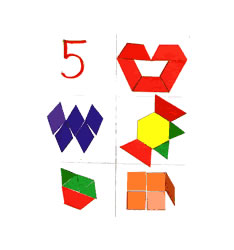Children as young as two years old are developing an intuitive sense of number.
Although they may not know how to count or understand what the words mean, they may be able to recognize a group of two or three objects.
As children get older, they can recognize more objects in a group and can picture the group of numbers in their minds.
As they develop more number sense, they learn that it is easier to picture numbers if they are arranged in patterns, like the patterns of dots on dice.
Playing number games with children is a great way to increase number sense.
Students in the 4 – 6 age range are working towards being able to:
- make sets of objects that match a given numeral e.g 3 blocks for the numeral “3”
- know the number name for a set of objects e.g saying “2” when presented with a set of two blocks
- match different numerals to groups of objects
- match numerals with pictures of objects and as two parts, e.g.1 blue block and 4 orange for the number
- compare quantities from 1 to 10 by: using one-to-one correspondence, by making sets and comparing sets that show more than, fewer than or as many as another set
- say what number comes before or next up to 10
- glance at sets of objects (1-5) and say how many they see e.g. 5 blocks on the table
- count by 1s, 5s, and 10s to 100 with understanding of what it means
Whole number operations (adding, subtracting, etc.)
The students are working towards being able to:
- understand and show with objects or pictures what the words “addition and subtraction” mean
- estimate numbers of objects – tell about how many blocks are on the floor
Fractions
The students are working towards being able to:
- cut real objects into halves, quarters, etc.
- understand what the words “half, quarter, thirds, halves, quarters” mean
- It is not necessary to teach symbols for fractions at this stage (1/2, 1/3…)Before children are able to learn fraction symbols and do operations (adding, subtracting…) with fractions, they require lots of time for play and fraction games to be able to visualize fractions and understand that fraction segments are equal parts of a larger object.
Learn how to teach kindergarten number skills with everyday things. ..
